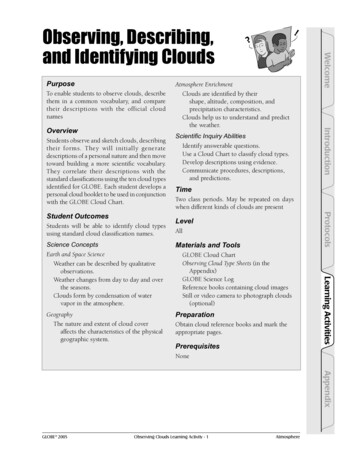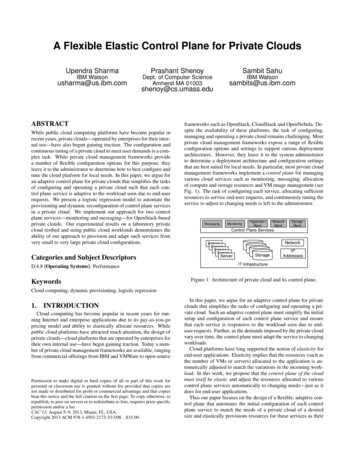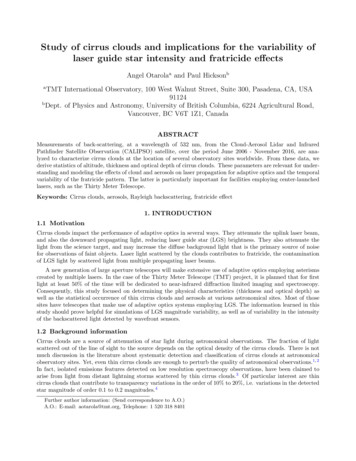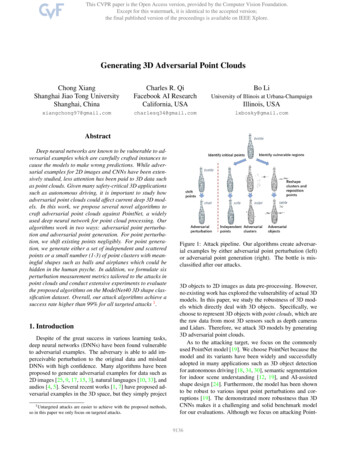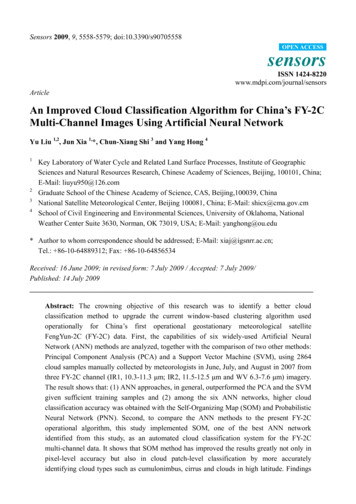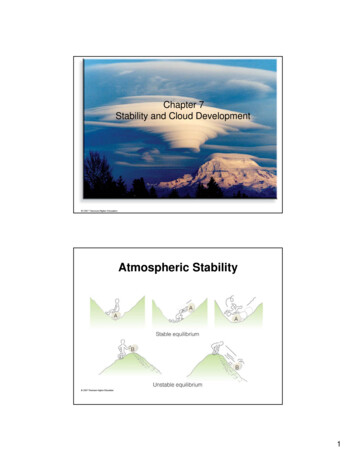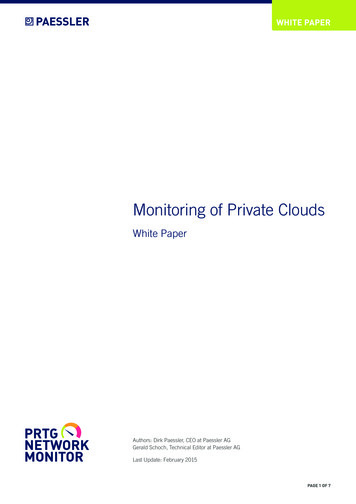
Transcription
WHITE PAPERMonitoring of Private CloudsWhite PaperAuthors: Dirk Paessler, CEO at Paessler AGGerald Schoch, Technical Editor at Paessler AGLast Update: February 2015PAGE 1 OF 7
WHITE PAPERContentsIntroduction .2The Private Cloud .3Network Monitoring as the Foundation for Private Cloud Planning . 3Consistent Network Monitoring Gains Importance in the Cloud . 3Private Cloud Monitoring from two Perspectives .4From the User’s Perspective .5From the Servers’s Perspective . 5Conclusion .7Introduction‘Cloud computing’ as a concept isn’t nearly as new as you might think.Previous approaches have been called ‘outsourcing’ and ‘server hosting,’ but insufficient processor performance, enormous hardware costsand slow Internet connections made everyday use difficult. However, today’s technology, broadband Internet connections and fast, inexpensiveservers, provide the opportunity to access only the services and storagespace that are actually necessary, and the ability to adjust these to meetcurrent needs. Using a virtual server, which is provided by a service provider, introduces a wide range of possibilities for cost savings, improvedperformance and higher data security. The goal of such cloud solutionsis a consolidated IT environment that effectively absorbs fluctuation indemand and capitalizes on available resources.PAGE 2 OF 7
WHITE PAPERThe Private CloudThe public cloud concept presents a number of challenges for a company’s IT department. Data security and the fear of ‘handing over’ control of the systems are significantissues. If an IT department is used to sequestering its systems with firewalls and to monitoring the availability, performance and capacity usage of its network infrastructure withan extensive monitoring solution, it is much more difficult to implement both measuresin the cloud. Of course, all large public cloud providers offer well-thought-out securitymechanisms and control systems, but the user must rely on the provider to guaranteeconstant access and to maintain data security.The creation of a ‘private cloud’ as an alternative to the use of public cloud is thereforean interesting possibility. Private clouds enable staff and applications to access IT resources as they are required, while the private computing centre or a private server ina large data centre is running in the background. All services and resources used in aprivate cloud are found in defined systems that are only accessible to the user and areprotected from external access. Private clouds offer many of the advantages of cloudcomputing and at the same time minimise the risks. As opposed to many public clouds,the quality criteria for performance and availability in a private cloud can be customised,and compliance to these criteria can be monitored to ensure that they are achieved.Network Monitoring as the Foundation forPrivate Cloud PlanningBefore moving to a private cloud, an IT department must consider the performancedemands of individual applications and cyclic fluctuations. Long-term analysis, trendsand peak loads can be attained via extensive network monitoring evaluations, and resource availability can be planned according to demand. This is necessary to guaranteeconsistent IT performance across virtualized systems.However, a private cloud will only function smoothly if a fast, highly reliable networkconnects the physical servers. For this reason, the entire network infrastructure mustbe analysed in detail before setting up a private cloud. This network must satisfy therequirements relating to transmission speed and stability, otherwise hardware or networkconnections must be upgraded. Ultimately, even minor losses in transmission speed canlead to extreme drops in performance. The IT administrator can use a comprehensivenetwork monitoring solution like PRTG Network Monitor, in the planning of the privatecloud. If an application (which usually equates to multiple virtualized servers) is going tobe operated over multiple host servers (“cluster”) in the private cloud, the application willneed to use Storage Area Networks (SANs), which convey data over the network as a central storage solution. This makes network performance monitoring even more important.CONSISTENT NETWORKMONITORING GAINSIMPORTANCE IN THE CLOUDIn terminal set ups in the 1980s, if a central computer broke down it was capable ofparalyzing an entire company. The same scenario could happen if systems in the cloudfail. Current developments show that we – coming from the concept of the mainframecomputer – have gone through a phase of widely distributed computing and storagepower (each workstation had a ‘full-blown’ PC) and returned to centralized IT concepts.The data is located in the cloud, and end devices are becoming more streamlined (RDP/Citrix terminals, tablets, smart phones, etc.). The new cloud, therefore, complies withthe old mainframe concept of centralized IT.The failure of a single VM in a highly-virtualized cloud environment can quickly interruptaccess to 50 or 100 central applications. Modern clustering concepts are used to try toavoid these failures, but if a system fails despite these efforts, it must be dealt with immediately. If a host server crashes and pulls a large number of virtual machines down with it, orits network connection slows down or is interrupted, all virtualized services on this host areinstantly affected, which, even with the best clustering concepts, often cannot be avoided.PAGE 3 OF 7
WHITE PAPERA private cloud – like any other cloud – depends on the efficiency and dependabilityof the IT infrastructure. Physical or virtual server failures, connection interruptions anddefective switches or routers can become expensive if they cause staff, automated production processes or online retailers to lose access to important operational IT functions.This means a private cloud also presents new challenges to network monitoring.To ensure that users have constant access to remote business applications, the performance of the connection to the cloud must be monitored on every level and from everyperspective. At the same time, smooth operation of all systems and connections withinthe private cloud must be guaranteed. And, of course, the administrator must keep aneye on the interaction between the private cloud and their own local IT landscape at thecompany location. An appropriate network monitoring solution accomplishes all of thiswith a central system; it notifies the IT administrator immediately in the event of possibledisruptions within the private IT landscape both on location and in the private cloud –even if the private cloud is run in an external computing centre.A feature of private cloud monitoring is that external monitoring services cannot ‘lookinto’ the cloud, as it – as the name suggests – is private. An operator or client must therefore provide a monitoring solution within the private cloud and, as a result, the IT staffcan monitor the private cloud more accurately and directly than a purchased service inthe public cloud. A private cloud also enables unrestricted access when necessary. Thisallows the IT administrator to track the condition of all relevant systems directly with aprivate network monitoring solution. This encompasses monitoring of every individualvirtual machine as well as the VMware host and all physical servers, firewalls, networkconnections, etc.Private Cloud Monitoring from TwoPerspectivesFor comprehensive private cloud monitoring, the network monitoring should have thesystems on the radar from user and server perspectives. If a company operates anextensive website with a web shop in a private cloud, for example, network monitoringcould be set up as follows:A website operator aims to ensure that all functions are permanently available to all visitors, regardless of how this is realised technically. The following questions are especiallyrelevant in this regard:INTERNETFIGURE 1:Schematic diagram of Paessler AG’sweb hosting in a private cloudSQL SERVERHYPERVISOR 1WWW 1SHOP 1FIREWALLLOAD BALANCERWWW 2SHOP 2HYPERVISOR 2PAGE 4 OF 7
WHITE PAPERFROM THE USER’SPERSPECTIVE Is the website online?Does the web server deliver the correct contents?How fast does the site load?Does the shopping cart process work?These questions can only be answered if network monitoring takes place from outsidethe server in question. Ideally, network monitoring should be run outside the relatedcomputing centre, as well. It would therefore be suitable to set up a network monitoring solution on another cloud server or another computing centre. It is crucial that alllocations are reliable and a failover cluster supports monitoring so that interruption-freemonitoring is guaranteed.This remote monitoring should include, in the above example of website monitoring: Firewall, HTTP load balancer and Web server pinging HTTP/HTTPS sensors for Monitoring loading time of the most important pages Monitoring loading time of all assets of a page, including CSS, images, Flash, etc. Checking whether pages contain specific words, e.g.: “Error” Measuring loading time of downloads HTTP transaction monitoring, for shopping process simulation Sensors that monitor the remaining period of SSL certificate validityFIGURE 2:This screenshot displays several PRTG sensorsthat are used for monitoring from the user perspective.FROM THE SERVER’SPERSPECTIVEIf one of these sensors finds a problem, the network monitoring solution will send anotification to the administrator. Rule-based monitoring is helpful here. If a Ping sensorfor the firewall, for example, times out, the PRTG Network Monitor offers the possibilityto pause all other sensors to avoid a flood of notifications, as, in this case, the connectionto the private cloud is clearly completely disconnected.Other questions are crucial for monitoring the (virtual) servers that are operating in theprivate cloud: Does the virtual server run flawlessly?Do the internal data replication and load balancer work?How high are the CPU usage and memory consumption?Is sufficient storage space available?Do email and DNS servers function flawlessly?PAGE 5 OF 7
WHITE PAPERThese questions cannot be answered with external network monitoring. Monitoring software must be running on the server or the monitoring tool must offer the possibility tomonitor the server using remote probes. Such probes monitor the following parameters,for example, on each (virtual) server that runs in the private cloud, as well as on the hostservers: CPU usageMemory usage (page files, swap file, page faults, etc.)Network trafficHard drive access, free disc space and read/write times during disc accessLow-level system parameters (e.g.: length of processor queue, context switches)Web server’s http response timeCritical processes, like SQL servers or Web servers, are often monitored individually, inparticular for CPU and memory usage. In addition, the firewall condition (bandwidthuse, CPU) can be monitored. If one of these measured variables lies outside of a definedrange (e.g. CPU usage over 95% for more than two or five minutes), the monitoringsolution will send notifications to the administrator.FIGURE 3:This screenshot displays the majority of the PRTGsensors that monitor the productive system fromthe server perspective.PAGE 6 OF 7
WHITE PAPERConclusionWith the increasing use of cloud computing, system administrators are facing newchallenges. A private cloud – like any other cloud – depends on the efficiency anddependability of the IT infrastructure. This means that the IT department must lookinto the capacity requirements of each application in the planning stages of the cloudin order to calculate resources to meet the demand. The connection to the cloud mustbe extensively monitored, as it is imperative that the user has constant access to allapplications during operation. At the same time, smooth operation of all systems andconnections within the private cloud must be guaranteed. A network monitoring solutionshould therefore monitor all services and resources from every perspective. This ensures continuous system availability. Capacity overloads can be systematically avoidedthrough long-term planning based on extensive monitoring data.ABOUT PAESSLER AGPaessler AG leads the industry in providing the most powerful, affordable and easy-touse network monitoring and testing solutions. The company’s suite of just-right softwareproducts deliver peace of mind, confidence and convenience for businesses of allsizes – from Small Office/Home Office (SOHO) to large enterprises, including more than70% of the Fortune 100 companies. Based in Nuremberg, Germany, Paessler’s globalreach includes more than 150,000 active installations of its products. Founded in 1997,Paessler AG remains a privately held company and is recognized as both a member ofthe Cisco Solution Partner Program and a VMware Technology Alliance Partner.NOTE:All rights for trademarks and namesare property of their respective owners.519179/EN/20150526Freeware and Free Trial versions of all products canbe downloaded from www.paessler.com/prtg/download.Paessler AG · www.paessler.com · info@paessler.comPAGE 7 OF 7
private network monitoring solution. This encompasses monitoring of every individual virtual machine as well as the VMware host and all physical servers, firewalls, network connections, etc. Private Cloud Monitoring from Two Perspectives. For comprehensive private cloud monitoring, the network monitoring should have the
